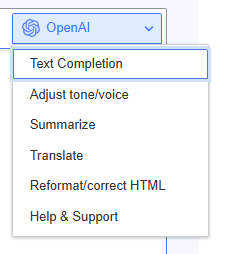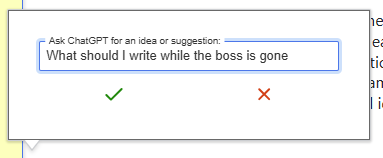Turning Ideas into Content with the OpenAI Drupal Module.
Helping You Create Content in Drupal
The OpenAI Drupal module makes it easier for anyone to take an idea and turn it into a finished piece of content right inside Drupal. It is designed for people who are responsible for keeping websites fresh and engaging, even if writing is not their main job. With this module, you can quickly draft text, improve existing content, or create supporting pieces like summaries and captions. The goal is to help you work more efficiently while keeping your own style and perspective at the center of the process.
What to Share with Your IT Team Before Installing
While you may not be the one installing the module, giving your IT team the right details will help them set it up in a way that supports your work. The module requires a few setup steps, permissions, and configuration choices that determine how you will use it.
Things to share with IT:
- Module Location: Available on Drupal.org. https://www.drupal.org/project/openai
- Compatibility: Confirm the site’s Drupal version is supported.
- Installation Steps: Install and enable the module from the admin interface.
- API Key Setup: Add a valid OpenAI API key in the module settings.
- Permissions: Assign access to user roles who will use the AI tools.
- Tone and Style Settings: Option to configure a tone vocabulary (friendly, professional, conversational) for consistent voice.
- Feature Configuration: Choose which AI-powered actions to enable, such as summarization, translation, tone change, and HTML correction.
- Content Workflow Integration: Ensure AI tools are available without bypassing existing approval steps.
Overview of the OpenAI Module Features
For writers the OpenAI module brings AI capabilities directly into Drupal’s content editing environment. It works with the tools you already use and can speed up every stage of content creation, from the first draft to the finishing touches.

Key things you can do with it:
- Generate Content: Create complete drafts from just a short idea or bullet points.
- Summarize Long Texts: Turn large amounts of text into short, clear overviews.
- Adjust Tone: Match the content’s tone to your audience using predefined styles like friendly, professional, or conversational.
- Translate Text: Provide multilingual versions of your content quickly.
- Correct HTML: Clean up formatting issues with one click.
- Work in the Editor: Access all features directly in Drupal’s editor without switching between tools.
The tone control feature is particularly useful for keeping a consistent voice across your site. Once set up, you can select a tone and instantly apply it to any content.
Writing with the OpenAI Drupal Module
Before you start typing your first sentence, the module can help you shape your ideas into a clear plan. You can enter a broad topic and ask for related subtopics, get a list of possible angles to cover, or generate a quick outline to structure your piece. These outlines can be expanded into full sections later, either with AI’s help or through your own writing.
Ways to use it in the ideation and outline phase:
- Brainstorm Topics: Turn a general theme into a list of potential article ideas.
- Generate Headlines: Explore multiple headline options before settling on one.
- Draft Outlines: Create a section-by-section breakdown of your content.
- Identify Supporting Points: Ask for examples, statistics, or related concepts.
- Refine Your Focus: Narrow down broad ideas into specific angles that will resonate with your audience.

Best Practices for AI-Assisted Writing
AI can make the writing process smoother, but the best results come when you guide it with intention. Think of AI as a creative partner that can help with structure, formatting, or first drafts, while you bring expertise, personality, and final polish.
Best practices to keep in mind:
- Treat AI as a collaborator: Use it to spark ideas and structure content, but make sure your voice leads.
- Maintain brand tone: Apply your site’s tone guidelines or use the module’s tone settings to keep output consistent.
- Always fact-check: Verify information before publishing.
- Refine for clarity: Ensure the final content reads naturally.
- Use AI for structure and flow: Let the module help with outlines, transitions, and readability while you focus on substance.
Extra tip: Demand no em dashes, horizontal lines, or emojis for all work.
Advanced Tips
Once you are comfortable using the basics, the OpenAI module can be taken further to support more complex or large-scale content needs.
Here are some advanced ways to use it:
- Create reusable prompt templates: Save prompts you use often so you can quickly apply them to new content.
- Leverage translation for multilingual sites: Instantly create language variations and refine them for cultural accuracy.
- Automate content touch-ups: Configure AI to check for tone, grammar, or clarity before final approval. (Speak to IT to configure)
- Test AI drafts in a staging workflow: Experiment with AI-generated drafts in a safe space before they go live.
Common Pitfalls and How to Avoid Them
Using AI can streamline your work, but it also introduces some risks if not handled thoughtfully.
Pitfalls to watch for:
- Overusing AI suggestions: Don’t lose your voice in your writing, stay on point.
- Unclear prompts: Be specific about tone, audience, and key points.
- Generic/Neutral tone: Apply your brand’s tone settings or rewrite sections to add personality.
- Neglecting SEO and accessibility: Review these elements before publishing.
- Know company AI policy: The machine overlords shouldn't know everything.
Security and Privacy Considerations
When you use the OpenAI module, you are sending text from your Drupal site to OpenAI’s servers for processing. The module does not store your content outside of Drupal unless you choose to save it, but OpenAI’s systems may temporarily store data.
Things to keep in mind:
- Understand the data flow: Know what content is sent to OpenAI and when.
- Avoid sharing sensitive details: Do not input personal or confidential data.
- Review OpenAI’s privacy policies: Understand retention and usage practices.
- Work with your IT team: Align settings with your organization’s data protection policies.
- Use appropriate permissions: Limit access to users trained on internal AI policy.
The Drupal AI Module and Initiative: Expanding the Possibilities
The OpenAI module remains a strong option for integrating AI into Drupal, but there is now a larger vision within the community. Drupal’s AI module and the broader AI Initiative provide a single, flexible framework for working with multiple AI providers and capabilities.
With the Drupal AI module, you can:
- Work with multiple providers: Connect to OpenAI, Anthropic, Cohere, Mistral, Azure OpenAI, or self-hosted models.
- Enhance your editor: Access AI-powered actions like tone adjustment, summarization, translation, and image alt text generation directly in CKEditor.
- Automate workflows: Use no-code AI automators to chain tasks such as generating summaries, suggesting taxonomy terms, or translating content.
- Improve search and chat: Build semantic search and conversational features using vector databases.
- Maintain quality and compliance: Use governance tools like logging, moderation, and audit trails.
- Stay adaptable: Use shared prompt templates and integrate new providers as they become available.
Give it a one shot.
Drupal’s OpenAI module gives content creators an accessible way to move from ideas to finished content quickly, while keeping creative control. It streamlines drafting, supports tone consistency, and integrates directly into the familiar Drupal editing environment. As Drupal’s AI module and initiative continue to grow, the possibilities will expand, bringing more tools, flexibility, and ways to create high-quality content. Whether you are a seasoned editor or someone who writes occasionally, now is the right time to explore how AI can become a supportive part of your publishing process.